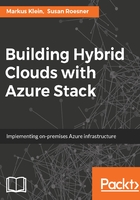
Summary
Azure Stack provides a real Azure experience in your datacenter. The UI, administrative tools, and even third-party solutions should work properly. The design of Azure Stack is a very small instance of Azure with some technical design modifications, especially regarding the compute, storage, and network resource providers. These modifications give you a means to start small, think big, and deploy large when migrating services directly to public Azure some time in the future, if needed.
The most important tool for planning, describing, defining, and deploying Azure Stack services is Azure Resource Manager, just like in Azure. This provides you with a way to create your services just once, but deploy them many times. From the business perspective, this means you have better TCO and lower administrative costs.
Azure Stack itself will be available as an integrated system (for production use). The minimum number of hosts is four and the maximum is 20 for version 1. For the development toolkit or setting up lab environments, there is a single host deployment available based on very basic hardware requirements. For general availability, the hardware OEMs are Dell EMC, HPE, and Lenovo; Cisco and other OEMs will follow soon.
Setting up Azure Stack is a straightforward solution using PowerShell. The deployment is divided into two main phases: the data collection section and the deployment section. Both sections steps can be easily resumed if they run into any issues. There is no deployment interruption at all.
In the following chapter, you will learn how to plan the deployment of Azure Stack and what you should think about before starting.